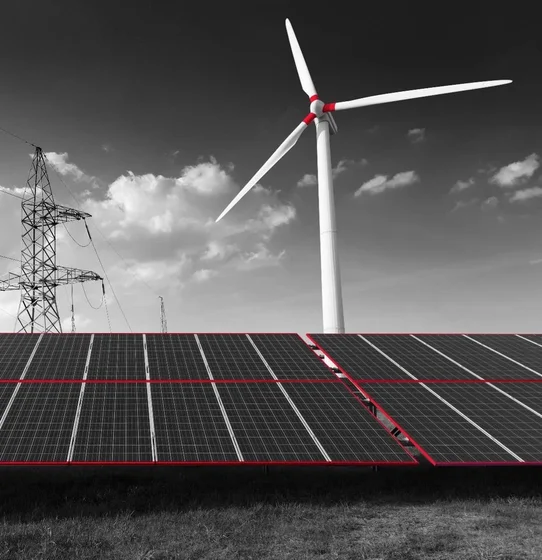
How nVent TRACHTE Power and Control Buildings Help Bring Renewable Energy to the Electrical Grid
As the world electrifies, the way we generate electricity to meet growing demand needs to shift as well. Renewable energy is becoming a larger part of our global electrical infrastructure, and that trend is only expected to accelerate. According to the International Energy Agency, renewable energy (wind, solar and hydro power), accounted for 80% of the total growth in electricity generation in 2024. This can be compared to 2023, when renewables accounted for only two thirds of total electricity growth.
Solar and wind farms are becoming a more common sight, and most people understand at a very basic level how renewable energy technologies work. However, between renewable energy sources and our homes and businesses lie complex systems specially engineered to collect, convert and connect power to substations. From there, it can be transmitted to and eventually used in the communities where we live and work. Engineered power and control (P&C) buildings from nVent TRACHTE are at the core of that process, playing an often overlooked yet essential role in delivering power from renewable energy sources to the grid.
Different Buildings, Different Jobs
There are two main types of P&C buildings used in renewable installations: collector and point-of-interconnect (POI). Collector buildings are placed throughout renewable energy installations and serve the function of gathering and consolidating energy from individual sources. They collect multiple power streams from wind turbines or solar panels into switchgear and accumulate that power into a single feeder out of the building. Depending on the size of the installation, renewables sites can use just one collector house or a series of them, and these buildings are typically owned by the site developer.
Once power has been collected and accumulated, it needs to be connected to the electrical grid; this is where POI buildings come in. In the United States, electrical power is supplied at 60 Hz, meaning that electrical signals are composed of 60 complete sine waves each second. Three phase power, used in utilities, contains three of these waves. Phase synchronization is the process of aligning, or synchronizing, the three phases from multiple sources. POI buildings are responsible for taking power streams from different collector buildings and combining and controlling their synchronization so they can be properly connected to utility transmission lines.
In addition to phase synchronization, POI buildings are also responsible for providing supervisory control and data acquisition (SCADA) systems. SCADA systems are essential for providing utilities with real-time visibility and management capabilities for reliable power generation, transmission and distribution. Finally, these buildings also contain protective relays, systems that detect unusual or unexpected activity upstream or downstream from the P&C building and activate failsafe mechanisms (like safely shutting down equipment due to faults), preventing system damage and minimizing downtime. This array of responsibilities makes POI buildings highly complex. They are also responsible for meeting the stringent standards of the power utility receiving the renewable energy on to the power grid. After the systems are commissioned, installed and approved, and renewable energy is generating, ownership of POI buildings typically transfers to the grid utilities.
Complicated Systems, Specialized Expertise
Designing, constructing and delivering P&C buildings for renewable installations is complicated, so these buildings are designed and engineered to order for a specific application. nVent TRACHTE P&C buildings are expertly engineered and manufactured to meet the stringent standards of utility-grade infrastructure. Our experts are experienced in properly integrating the enclosed equipment to make sure it works in harmony.
Furthermore, because of the critical nature of these buildings’ functions, contractors and developers need to trust that equipment will be reliable long before it gets into the field. This reliability and durability must extend into the future as well, with equipment being able to match the typical 30-year design life of renewables infrastructure. We offer customizable and repeatable factory acceptance testing to validate workmanship and proper operation to provide peace of mind for our customers. It is also important to seek partners who have existing relationships and established trust with utilities that can serve as partners in proactively meeting the needs of these customers—with decades of experience working with U.S. utilities, can meet that challenge.
Even when P&C buildings are appropriately built to meet or exceed specifications, designing and manufacturing a building is just step one. Solar and wind farms are often located in remote areas, so safe transportation to the site is a challenge. P&C buildings can be described as the “enemy of shipping”—they are wide, long, tall, heavy, and often transported to remote areas. The logistics of transporting an oversized super load to a remote area bring unique challenges to every shipment . When looking at P&C building manufacturers, make sure to pick a supplier like nVent TRACHTE who can actually deliver the goods safely and on time.
Finally, contractors need to consider how to protect P&C buildings when they’re in the field. The same remote environments that make initial installation challenging also make service difficult and expensive. Engineers need to make sure they are consulting with experts who are well versed in the design and engineering of protection systems for renewables applications and able to meet the requirements of the final site location. Drawing on our broad portfolio of solutions across the nVent business, we can provide expert advice on everything from enclosures and cooling, to grounding and bonding, to lightning protection.
P&C buildings play a critical role in our electrified future, helping clean and resilient power reach the electrical grid where it can ultimately be put into action serving our communities. The next time you are driving past a wind or solar farm, keep an eye out for collector and POI buildings in action!